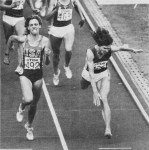Great Matchups — Mary Decker vs. The Soviets: Helsinki 1983

Landing on her chest and knees [Zaytseva] and sliding across the finish with her knees over the rail, as Decker (4:00.90) had captured her second gold in dramatic fashion.
From Track & Field News
HELSINKI, Finland—Mary Decker surprised the experts at the IAAF’s first-ever World Championships. TFN’s WC Preview had tabbed her for 4th in the 1500 and a silver in the 3000. Instead, the former wunderkind, still only 25, parlayed a pair of great homestretch drives into double golds. Here, from the September 1983 issue, are the three pieces we wrote about the inspired running that landed the future Mary Slaney on our cover:
3000: Decker Stuns Soviets in the Stretch
By Bob Hersh
How good is Mary Decker? Until the Helsinki 3000 we could never be sure. In spite of a portfolio of excellent times at distances from 800 through 10,000 meters, she had been untested recently against the Soviets, whose corps of middle distance runners defines world class in these events.
The last time Decker had faced any USSR runner was in Zürich in ’80. The distance then was 1500, and although Decker set an American record, she was beaten by 50 yards as Tatyana Kazankina set a world record that still stands.
It was all the more significant, then, that 2-time Olympic 1500 gold medalist Kazankina turned out to be one of the Soviet entries in the 3000 in Helsinki. Another was Svetlana Ulmasova, the world record holder. She won the first heat (which eliminated Brenda Webb and Monica Joyce), while Kazankina and Decker virtually dead-heated in the second (which knocked out Maggie Keyes).
The third Soviet entry was 20-year-old Natalya Artyomova, who barely qualified out of the first heat. With apparently better entries at home, Artyomova’s presence gave rise to some speculation as to her intended role. Would she be used as a sacrificial lamb and try to trap Decker into following a suicidal pace? Would she be used as a blocking back? “We are aware of both of those possibilities,” said Dick Brown, Decker’s coach, “and we’re prepared for them.”
As it turned out there was little need for any such preparation. Decker controlled the final from beginning to end without the slightest interference from the Soviets or anyone else. She split 66, 70,71, 71, 71, 70 through the first 6 laps. “We started out a little faster than I had wanted; then it was a little slower,” Mary recalled, “but I wasn’t really concerned. I know I’m strong enough and I had confidence in my kick. Also, I knew that the slower I could run the race and still win, the better off I’d be for the 1500.”
Although Decker’s pace was not fast enough to threaten any records, it did separate the field. After a few laps, the only runners left in close contact with the lead were the two top Soviets, Brigitte Kraus, Wendy Sly and Agnese Possamai.
The order of this group shuffled back and forth some, but Decker remained in front always. This caused some of her fans to wonder if she could bear the psychological burden of setting the pace for the entire course. Not to worry: “Unless someone else is setting a 64-65 pace, or something crazy, it doesn’t bother me at all to be in the lead. I actually find it more relaxing to lead than to follow. I didn’t mind doing it.”
Continue reading, includes complete 3000m & 1500m results with splits, at: trackandfieldnews.com
